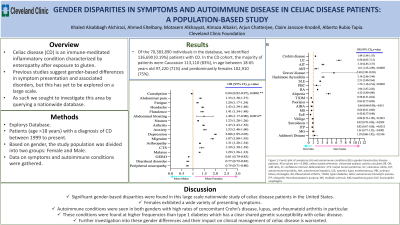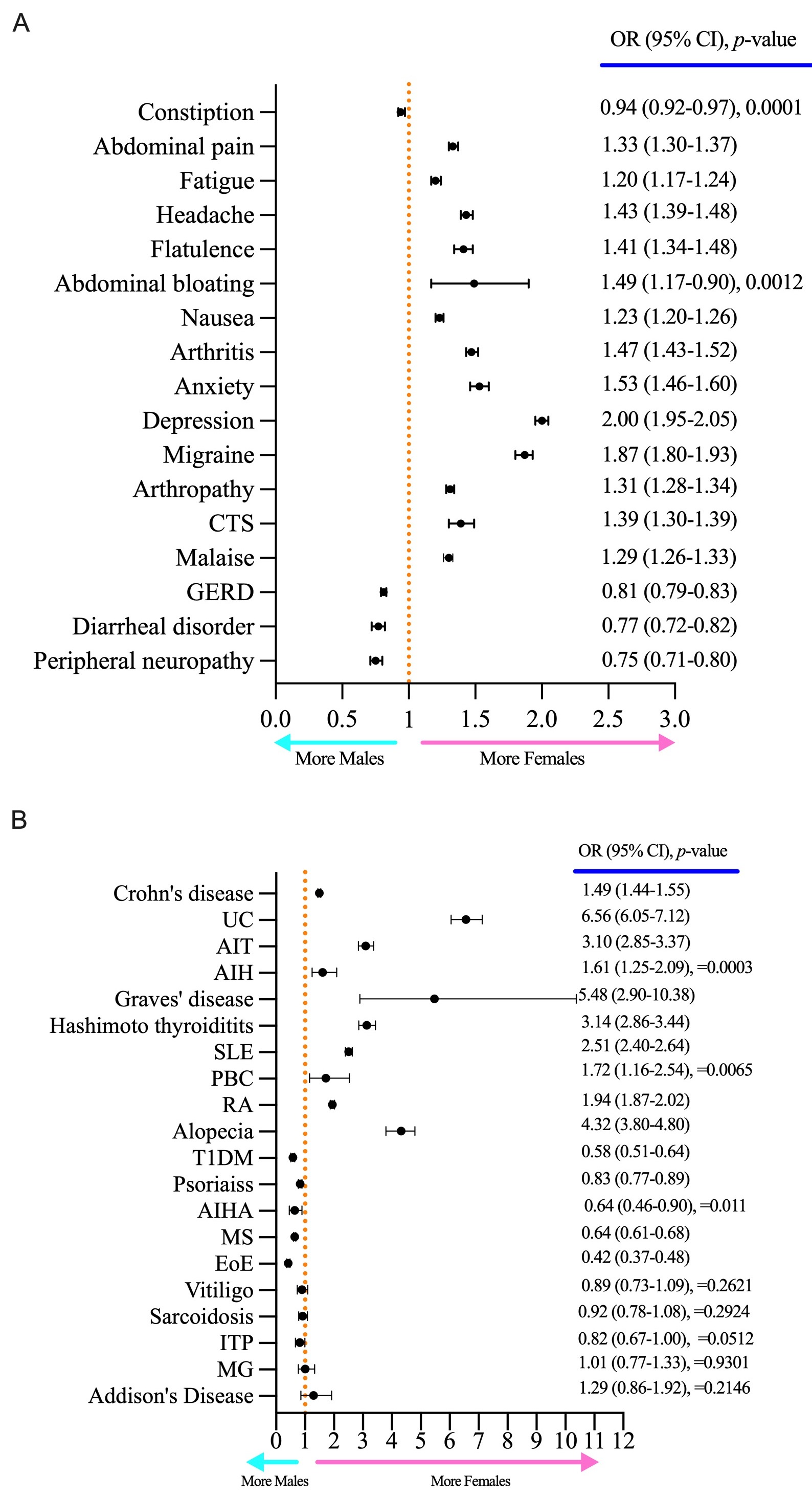Back


Poster Session A - Sunday Afternoon
Category: Small Intestine
A0639 - Gender Disparities in Symptoms and Autoimmune Disease in Celiac Disease Patients: A Population-Based Study
Sunday, October 23, 2022
5:00 PM – 7:00 PM ET
Location: Crown Ballroom

Has Audio
.jpg)
Khaled Alsabbagh Alchirazi, MD
Cleveland Clinic
Cleveland, OH
Presenting Author(s)
Khaled Alsabbagh Alchirazi, MD1, Ahmed Eltelbany, MD, MPH1, Motasem Alkhayyat, MD2, Almaza A. Albakri, MD3, Arjun Chatterjee, MD2, Claire Jansson-Knodell, MD2, Alberto Rubio Tapia, MD1
1Cleveland Clinic, Cleveland, OH; 2Cleveland Clinic Foundation, Cleveland, OH; 3Royal Jordanian Medical Services, Amman, Al Karak, Jordan
Introduction: Celiac disease (CD) is an immune-meditated inflammatory condition characterized by enteropathy after exposure to gluten. Previous studies suggest gender-based differences in symptom presentation and associated disorders, but this has yet to be explored on a large scale. As such we sought to investigate this area by querying a nationwide database.
Methods: We used a commercial database (Explorys Inc, Cleveland, OH) which includes electronic health record data from 26 major integrated US healthcare systems. Based on Systematized Nomenclature of Medicine – Clinical Terms (SNOMED-CT), we identified all patients (age >18 years) with a diagnosis of CD from 1999 to 2022. Based on gender, the study population was divided into two groups: Female and Male. Data on symptoms and autoimmune conditions were gathered.
Results: Of the 70,383,890 individuals in the database, we identified 136,690 (0.19%) patients with CD. In the CD cohort, the majority of patients were Caucasian 113,110 (83%), in age between 18-65 years old 97,220 (71%) and predominantly females 102,910 (75%). Abdominal pain, abdominal bloating, nausea, flatulence, headache and arthropathy were seen more in females compared with males. Whereas diarrhea and peripheral neuropathy were seen more in males (Figure 1; A). Some concomitant autoimmune diseases were more frequent in women including autoimmune thyroiditis, crohn’s disease, ulcerative colitis, rheumatoid arthritis, autoimmune hepatitis and alopecia, while others predominated in men such as eosinophilic esophagitis, type 1 diabetes and psoriasis (Figure 1; B).
Discussion: Significant gender-based disparities were found in this large scale nationwide study of celiac disease patients in the United States. Females exhibited a wide variety of presenting symptoms. Autoimmune conditions were seen in both genders with high rates of concomitant Crohn’s disease, lupus, and rheumatoid arthritis in particular. These conditions were found at higher frequencies than type 1 diabetes which has a clear shared genetic susceptibility with celiac disease. Further investigation into these gender differences and their impact on clinical management of celiac disease is warranted.

Disclosures:
Khaled Alsabbagh Alchirazi, MD1, Ahmed Eltelbany, MD, MPH1, Motasem Alkhayyat, MD2, Almaza A. Albakri, MD3, Arjun Chatterjee, MD2, Claire Jansson-Knodell, MD2, Alberto Rubio Tapia, MD1. A0639 - Gender Disparities in Symptoms and Autoimmune Disease in Celiac Disease Patients: A Population-Based Study, ACG 2022 Annual Scientific Meeting Abstracts. Charlotte, NC: American College of Gastroenterology.
1Cleveland Clinic, Cleveland, OH; 2Cleveland Clinic Foundation, Cleveland, OH; 3Royal Jordanian Medical Services, Amman, Al Karak, Jordan
Introduction: Celiac disease (CD) is an immune-meditated inflammatory condition characterized by enteropathy after exposure to gluten. Previous studies suggest gender-based differences in symptom presentation and associated disorders, but this has yet to be explored on a large scale. As such we sought to investigate this area by querying a nationwide database.
Methods: We used a commercial database (Explorys Inc, Cleveland, OH) which includes electronic health record data from 26 major integrated US healthcare systems. Based on Systematized Nomenclature of Medicine – Clinical Terms (SNOMED-CT), we identified all patients (age >18 years) with a diagnosis of CD from 1999 to 2022. Based on gender, the study population was divided into two groups: Female and Male. Data on symptoms and autoimmune conditions were gathered.
Results: Of the 70,383,890 individuals in the database, we identified 136,690 (0.19%) patients with CD. In the CD cohort, the majority of patients were Caucasian 113,110 (83%), in age between 18-65 years old 97,220 (71%) and predominantly females 102,910 (75%). Abdominal pain, abdominal bloating, nausea, flatulence, headache and arthropathy were seen more in females compared with males. Whereas diarrhea and peripheral neuropathy were seen more in males (Figure 1; A). Some concomitant autoimmune diseases were more frequent in women including autoimmune thyroiditis, crohn’s disease, ulcerative colitis, rheumatoid arthritis, autoimmune hepatitis and alopecia, while others predominated in men such as eosinophilic esophagitis, type 1 diabetes and psoriasis (Figure 1; B).
Discussion: Significant gender-based disparities were found in this large scale nationwide study of celiac disease patients in the United States. Females exhibited a wide variety of presenting symptoms. Autoimmune conditions were seen in both genders with high rates of concomitant Crohn’s disease, lupus, and rheumatoid arthritis in particular. These conditions were found at higher frequencies than type 1 diabetes which has a clear shared genetic susceptibility with celiac disease. Further investigation into these gender differences and their impact on clinical management of celiac disease is warranted.

Figure: Figure 1: Forest plot of symptoms (A) and autoimmune conditions (B) in gender based-celiac disease patients. All p-values are < 0.0001 unless stated otherwise. Univariate analysis used to calculate OR. OR; odd ratio, CI; confidence interval.
Abbreviations: CTS: Carpal tunnel syndrome, UC; ulcerative colitis, AIT; autoimmune thyroiditis, AIH; autoimmune hepatitis, SLE; systemic lupus erythematosus, PBC; primary biliary cholangitis, RA; Rheumatoid arthritis, T1DM; type1 diabetes, AIHA; autoimmune hemolytic anemia, ITP; idiopathic thrombocytopenic purpura, MS; multiple sclerosis, MG;myasthenia gravis EoE; Eosinophilic esophagitis.
Abbreviations: CTS: Carpal tunnel syndrome, UC; ulcerative colitis, AIT; autoimmune thyroiditis, AIH; autoimmune hepatitis, SLE; systemic lupus erythematosus, PBC; primary biliary cholangitis, RA; Rheumatoid arthritis, T1DM; type1 diabetes, AIHA; autoimmune hemolytic anemia, ITP; idiopathic thrombocytopenic purpura, MS; multiple sclerosis, MG;myasthenia gravis EoE; Eosinophilic esophagitis.
Disclosures:
Khaled Alsabbagh Alchirazi indicated no relevant financial relationships.
Ahmed Eltelbany indicated no relevant financial relationships.
Motasem Alkhayyat indicated no relevant financial relationships.
Almaza Albakri indicated no relevant financial relationships.
Arjun Chatterjee indicated no relevant financial relationships.
Claire Jansson-Knodell: Clearpoint Neuro Inc – Stock-publicly held company(excluding mutual/index funds). Dariohealth Corp Com – Stock-publicly held company(excluding mutual/index funds). DermTech Inc – Stock-publicly held company(excluding mutual/index funds). DiaMedica Therapeutics Inc. – Stock-publicly held company(excluding mutual/index funds). Exact Sciences – Stock-publicly held company(excluding mutual/index funds). Inari – Stock-publicly held company(excluding mutual/index funds). Nano-X imaging ltd – Stock-publicly held company(excluding mutual/index funds). Outset medical – Stock-publicly held company(excluding mutual/index funds). PavMed – Stock-publicly held company(excluding mutual/index funds). Transmedics Group Inc – Stock-publicly held company(excluding mutual/index funds).
Alberto Rubio Tapia indicated no relevant financial relationships.
Khaled Alsabbagh Alchirazi, MD1, Ahmed Eltelbany, MD, MPH1, Motasem Alkhayyat, MD2, Almaza A. Albakri, MD3, Arjun Chatterjee, MD2, Claire Jansson-Knodell, MD2, Alberto Rubio Tapia, MD1. A0639 - Gender Disparities in Symptoms and Autoimmune Disease in Celiac Disease Patients: A Population-Based Study, ACG 2022 Annual Scientific Meeting Abstracts. Charlotte, NC: American College of Gastroenterology.
